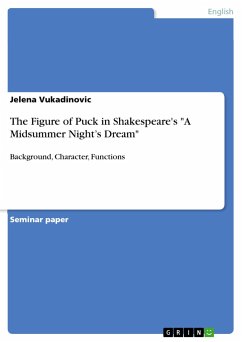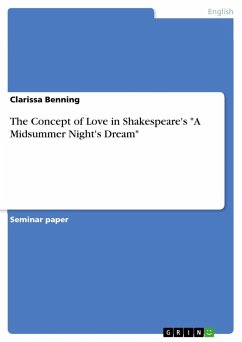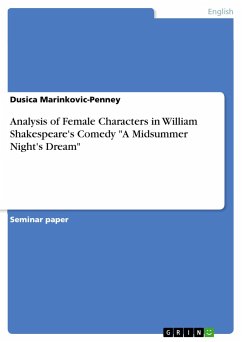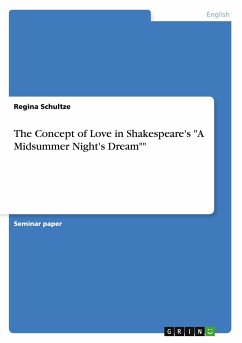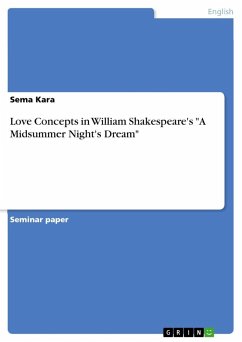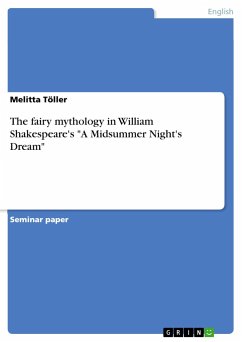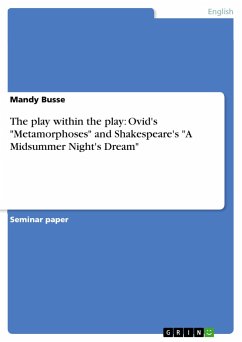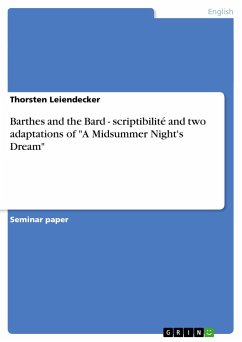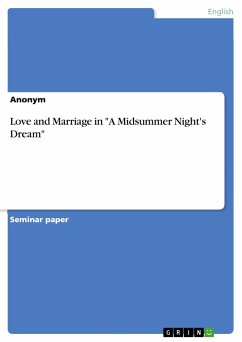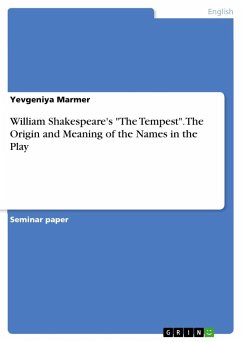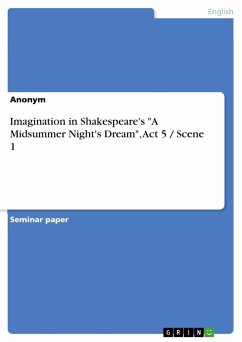
Imagination in Shakespeare's "A Midsummer Night's Dream", Act 5 / Scene 1

PAYBACK Punkte
0 °P sammeln!
Seminar paper from the year 2010 in the subject English Language and Literature Studies - Literature, grade: 1,0, University of Erfurt (Philosophische Fakultät), course: Shakespearean Comedy, language: English, abstract: The "dream" in "A Midsummer Night's Dream" implies a world of imagination, illusion and unconsciousness. In addition, the tradition and the popular beliefs of the midsummer festivals describe a time of unleashed natural forces (BOOCK, 1981: 70). The audience of the play indeed witnesses magical incidents in the fairies' forest, where the fairy king and queen, Oberon and Titan...
Seminar paper from the year 2010 in the subject English Language and Literature Studies - Literature, grade: 1,0, University of Erfurt (Philosophische Fakultät), course: Shakespearean Comedy, language: English, abstract: The "dream" in "A Midsummer Night's Dream" implies a world of imagination, illusion and unconsciousness. In addition, the tradition and the popular beliefs of the midsummer festivals describe a time of unleashed natural forces (BOOCK, 1981: 70). The audience of the play indeed witnesses magical incidents in the fairies' forest, where the fairy king and queen, Oberon and Titania, rule over the natural processes. Human beings seem to behave irrationally under the spell of these fairies and in the surrounding of this magic forest (SHAKESPEARE, 1980: II - IV). However, in contrast, the city of Athens is dominated by the rational Theseus, duke of Athens, who only believes in what cool reason is able to produce and to understand (SHAKESPEARE, 1980: V, i, 2 - 22). The contrast of imagination and reason represents one of the major oppositional pairs of themes of "A Midsummer Night's Dream" (KERRIGAN, 1998: 20ff). It becomes indirectly clear through the opposing worlds of forest and city and the ongoing actions in these two places. Furthermore, in the last scene of the play, the audience experiences directly a controversy between Theseus and his wife, Hippolyta, concerning the truth of the story about the incidents in the forest happened to the young Athenians Hermia, Helena, Lysander and Demetrius. Consequently, it is also a controversy about the value of imagination and reason (SHAKESPEARE, 1980: V, i, 1 - 27). Moreover, questions of imagination are brought up on another level. The play within the play of "Pyramus and Thisbe", which is rehearsed by craftsmen throughout the story and performed at the wedding ceremony in the last scene, offers an increase of imaginative perspectives. Its content not only mirrors the main plot, but it also emphasises the role auf the audience in the imaginative process (DENT, 1964: 127 and PFISTER, 2000: 408 and WILLSON, 1981: 88 and WILLSON, 1974: 102ff and ZIPFEL, 2007: 212). These aspects will be discussed further in this research paper. As the title suggests, the focus is on the very last scene of the play. Nevertheless, it is also necessary to establish connections to other parts of "A Midsummer Night's Dream", because no scene can be examined in an isolated form. Especially in the case of the last scene, the reflection of the main actions by the play within the play results in references to several plot lines.




